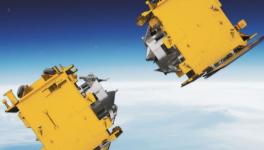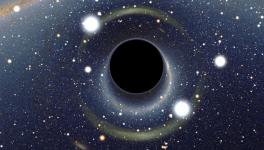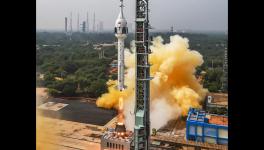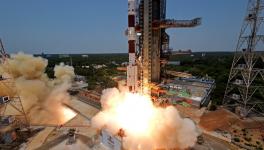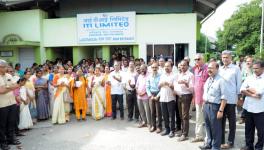Chandrayaan-2 and the Indian Space Journey
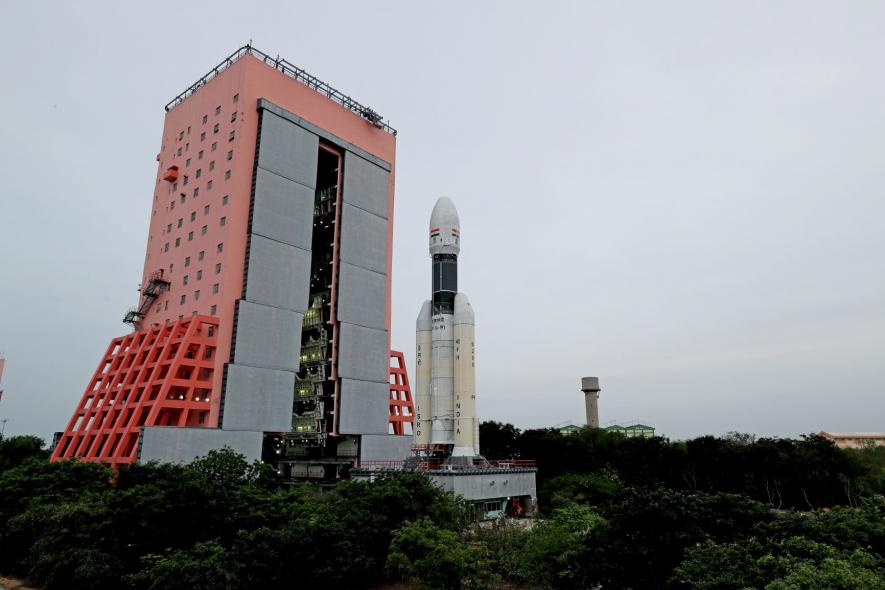
India's on-going space exploration programme takes its next step with the launch on July 15, 2019 of Chandrayaan-2, the Indian Space Research Organisation’s (ISRO) second venture to the moon. The first mission was mainly conducted by the orbiting spacecraft while a probe with the Indian flag was sent to crash on the moon’s surface, symbolically “planting” the Indian tricolour on the moon. Chandrayaan-2, in contrast, is taking a huge step forward for India by attempting soft landing of a craft with a rover on the moon, while the orbiting vessel continues with various observations and experiments.
Barring any unforeseen accident, the Chandrayaan-2’s launch itself on ISRO’s most powerful rocket to date, the GSLV-III (Geo-Stationary Launch Vehicle), is expected to go smoothly, having been put through numerous pre-launch tests, simulations and ground runs. Unfortunately, how the mission proceeds and especially whether it culminates successfully will not be known until mid-September when the vehicle reaches the moon, so discussion of those aspects will have to await those events which are still quite a long way away.
If pre-launch publicity and past experiences are anything to go by, the expected successful launch will be followed by swooning praises of India’s space-faring capabilities, boasts about the number of firsts India has achieved through Chandrayaan-2, and preening self-congratulations about how many major powers India is ahead of in space, all of which are to be read as underlining the fact that India is knocking at the doors of superpower status. This gushing, chest-thumping, flag-waving atmosphere will not provide a good context for a dispassionate discussion about the current and foreseeable future of India’s space programme, what Chandrayaan-2 tells us about it, nor what else could be attempted so as to improve it. So, although there is always a risk of being declared “professional skeptics” or even “anti-national,” perhaps the present pre-launch window presents a better opportunity for such a discussion.
THE LAUNCH
Purely from an Indian point of view, the mission makes several new, even if not pioneering, steps.
The GSLV-III launch vehicle is ISRO’s heaviest, capable of placing a 4 ton spacecraft in Geo-Stationary Transfer Orbit (GTO), and around 8 tons in Low-Earth Orbit, whereas the earlier GSLV rocket had a maximum capacity of around 2.3 tons. This heavier lift capability is required not only for Chandrayaan-2, which has to carry the 2,739 kg Chandrayaan-2 Orbiter mother vessel as well as a 1,471 kg Lander named Vikram (after pioneering space scientist Vikram Sarabhai) and a tiny 27 kg Rover named Pragyaan (wisdom) that will piggy-back on the orbiter, but also larger communication satellites in future. This will help ISRO launch the larger communications satellites India now requires, and which are at present launched by the European Ariane rocket from equatorial Guinea. To put things in perspective, however, this is still a relatively small payload and would lead to a classification of the GSLV-III as, at best, a “medium-lift” rocket. In comparison, Elon Musk’s Space-X Falcon ‘Heavy’ can lift payloads of 26.7 tons to GTO and 63.8 tons to LEO, or even 16 tons to Mars.
The GSLV-III is also slated to launch India’s first manned space flight Gaganyaan in 2020, whose spacecraft including the 3-man crew module is expected to weigh just under 8 tons, and is slated to orbit the Earth at around 400 km altitude.
To make things clear, even this higher payload capacity of GSLV-III, compared to earlier GSLV versions forget the PSLV launchers, continues to impose considerable restrictions on what ISRO can launch in the coming years. It is for this reason that the Chandrayaan-2 Mission takes about two months to reach the moon.
The spacecraft will first be placed in an Earth Parking Orbit of 170km perigee (shortest distance from the centre of the earth in an elliptical orbit) and 40,200 km apogee (longest distance). It will then be subject to a series of rocket boosts or orbit raising maneuvers designed to propel the craft in increasingly elongated orbits in the direction of the moon until it reaches an altitude where it gets captured by the moon’s gravity in a Lunar Injection Orbit, from where it is maneuvered into its final 100km x 100km lunar polar orbit.
This kind of a launch, which was also used by ISRO during its Mangalyaan Mars Mission, using the Earth’s gravity and a highly elliptical orbit to propel the spacecraft like a slingshot, towards Mars, may have been forced upon ISRO because of the payload capacity of its rockets. Nevertheless, it is increasingly preferred even internationally for robotic launches (ie, in which no humans are involved) where time is not critical, due to lower costs since less fuel is burnt and gravity is used to do most of the work.
However, it will certainly impose quite severe limitations for Indian manned space missions. The Gaganyaan mission is planned to have a 3-man crew orbit the Earth in low-earth orbit only, and that is the maximum achievable with GSLV-III. India’s planned space station too will be quite small, with capacity to host 2-3 people for about 7 days in low-earth orbit, nothing like the mammoth Soviet and International Space Stations designed for long duration orbital programmes. This again is due to the payload limitations of ISRO’s rockets.
The loud and clear message is that ISRO needs to accelerate work towards developing heavy lift capability. Such capability would be especially important if India intends seriously pursuing an extensive manned space programme, and we shall return to this theme later. But it will also be crucial if India wants to conduct more extensive lunar expeditions, explore the solar system and deep space beyond it, and work on larger space stations and other experiments in space. Till now, ISRO has creatively used the restrictions imposed by its limited lift capabilities, as well as relatively limited budgets, to develop innovative and low-cost techniques to excellent effect. Henceforth, however, these limitations will require to be overcome or will constrain what India can expect to do in space. This reality will definitely assert itself if, as ISRO has been claiming of late, it is changing the emphasis of its programmes from applications such as earth observation and communications, whether civilian or military, to curiosity-driven science in deep space.
THE LUNAR MISSION
Chandrayaan-1 was simply about getting to the moon and then conducting some relatively simple exploration tasks while in orbit around it. Chandrayaan-2 is about much more, and there are indeed several firsts for India.
First, there is the soft landing. ISRO has chosen to land near the south pole of the moon, which nobody else has so far, attempted. A near-equatorial landing on the lunar surface has been generally preferred in all missions by other nations till now because the terrain here is comparatively more uniform than at the polar regions which have more craters, with the added challenge of communication-shadow regions. The moon’s polar regions, especially the south pole, are also extremely cold, with perhaps among the coldest parts of the solar system at minus 248 degrees celsius, due to the axis of the moon which is tilted at only 1.54 degrees compared to Earth’s 23.5 degrees. Some places are almost permanently in the dark.
On the other hand, the same conditions also make it more likely that ice water may be available in the lunar poles, especially at the bottom of craters, which have probably laid undisturbed for very long, and may even contain fossil and geological features dating back to the origins of the solar system. If indeed water is abundant here, these locations may become the preferred sites for any future lunar stations as some other nations are planning.
Originally, Russia was to design the Chandrayaan-2 Lander and Rover but gave up a few years ago because of difficulties their designs ran into. So ISRO picked up the gauntlet and completed the design and fabrication completely through indigenous efforts. Kudos to ISRO!
The Lander will separate from the mother craft, and maneuver itself into a lower 30km x 100 km lunar orbit using its main liquid fueled engine and, after completion of various checks, will descend to the moon’s surface using its several, smaller engines. The identified landing site is a relatively high plain between two craters, the optimum site given the difficult terrain and extremely inhospitable conditions at the pole. The terrain also complicates the soft landing, which calls for autonomous steering avoiding obstacles, craters and rocks, and control of the speed of descent by the Lander. Due to low lunar gravity and lack of atmosphere around the moon, parachutes cannot be used and the only way is to control the descent by appropriately braking the descent by firing the rockets on the Lander. ISRO envisages this to be the most difficult and crucial part of the mission.
After landing, the Rover detaches itself from the Lander and begins its exploration of the lunar surface. The Rover can only communicate with the Lander and is controlled by it, whereas the Lander can communicate both with the mother ship and ISRO’s deep space monitoring centres back on Earth.
Once again, the capabilities of the Lander and Rover are constrained by the payload limitations of the GSLV-III. As readers may surmise, manned landings on the moon are not feasible within the existing capabilities and will have to await more powerful ISRO rockets so as to reach the moon directly from Earth in four to five days and the Rover has a limited range of 500 m, runs on solar power and has on-board systems that can switch it to ‘sleep’ mode to conserve power. This may enable it to do its tasks beyond its estimated useful life of around 14 Earth days or one lunar day. The Lander too is expected to complete its tasks in the same duration. The Rover will conduct on-site chemical analysis of minerals it finds. The Orbiter has on board five scientific instruments, the Lander has four and the Rover two. Together these will enable compilation of date and conduct of studies of the moon’s exosphere, minerals, mapping of the lunar terrain, study of temperature and seismic profile of the moon’s surface, and study of lunar minerals and geology etc.
ISSUES FOR THE FUTURE
As stated in the beginning, there are many things to ponder about regarding future activities in India’s space programme. We have already dealt with one major requirement, namely for more powerful rockets.
Another major issue is the manned or human programme. Frankly, most countries undertake such missions as a matter of prestige, to show they can do it, which was then US President John F Kennedy’s main motivation, especially beating the Soviet Union in the space race, a goal considered extremely important by the US at that time for ideological reasons. The Soviets never attempted to land a human being on the moon, but now China wants to beat the US at its own game, India does not want to be left too far behind, and the US in turn has announced it is planning to go to the moon again and, this time, stay there in a permanent Lunar Station. But nobody till date has been able to satisfactorily explain what a human being can achieve scientifically in space that a robot cannot do. Of course, domestic morale is important as are feelings of national pride, but only within limits. In this writer’s firm opinion, India should think long and hard before embarking on any extensive human space programme beyond a few demonstrative human space flights.
Every country wishes, and science too demands, that something new be undertaken on each space flight. In this, India should avoid falling into the “me too” and “me first” traps. True, India will be the first to land in the lunar south pole, as China was in landing on the dark side of the moon. But there must be something more interesting and exciting than such incremental gains in knowledge or feats of bravado. India needs to imaginatively come up with bright, novel and scientifically challenging ideas on what to do in space when we get there. Since one of ISRO’s stated goals of Chandrayaan-2 is to excite young minds in India, perhaps a competition inviting bright, realisable and new ideas for space exploration would be a good idea.
Lastly, India should pursue more active international collaboration in space. Patriotic zeal is good, but space should quintessentially be an exercise in inter-national collaboration for the common good of humankind.
Get the latest reports & analysis with people's perspective on Protests, movements & deep analytical videos, discussions of the current affairs in your Telegram app. Subscribe to NewsClick's Telegram channel & get Real-Time updates on stories, as they get published on our website.









